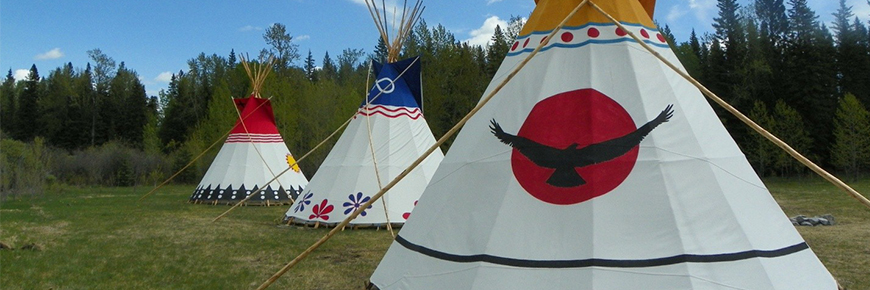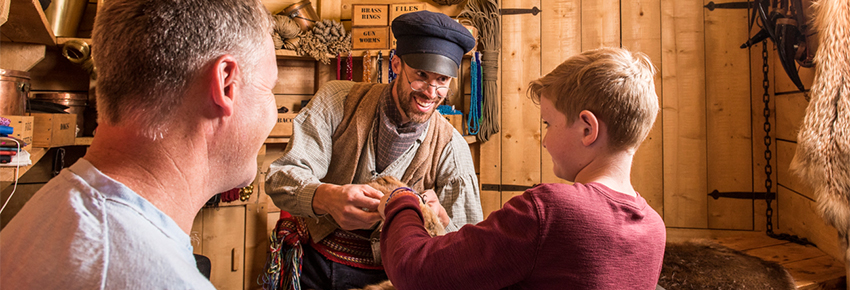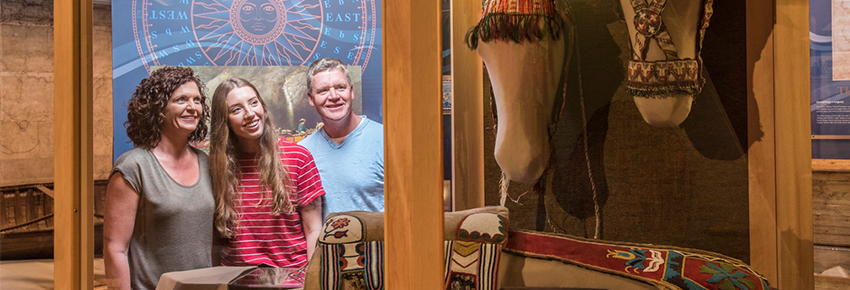
Unearthing history
Rocky Mountain House National Historic Site
Parks Canada archaeologists and historians work together. They use the lay of the land, artefacts, journals, letters, oral histories and much more to reveal the story of Rocky Mountain House. History is always changing. There are still many mysteries to solve.
Each National Historic Site of Canada has a Statement of Commemorative Intent. The statement describes the reasons for the site’s national significance.
Rocky Mountain House is of national historic significance because of its role in the historic fur trade; its association with David Thompson and explorations toward the westward; and its relationship with the Blackfoot peoples (Nitsitapii), particularly the Peigan (Piikani).”
Two Fur Trade Companies
The North West Company and the Hudson's Bay Company established fur trade posts at Rocky Mountain House in 1799. The two companies were in business competition with each other. Both companies built posts side-by-side all along the North Saskatchewan River. Just as we see fast-food chains side-by-side on our highways today.

© Scott Munn / Parks Canada
The fur trade posts at Rocky Mountain House were small and remote. This was not the realm of officers and gentlemen. Here was the fur trade family at work. Daily life included fur presses, capotes, point blankets, and pemmican. Fur trade posts had a special kind of wood construction.
The two companies brought international trade goods like tea, firearms, gunpowder, axes, glass beads, copper pots, and more. They traded these items for fur and food brought to them by Indigenous Peoples.
The two companies were in a business war for many years. In 1821, they joined forces under one name: Hudson’s Bay Company. However, they kept the North West Company post name of Rocky Mountain House.
Trade existed at Rocky Mountain House for 76 years. Many well-known characters visited or lived here during that time:
- Paul Kane, artist
- Captain John Palliser of the Palliser Expedition,
- Alexander Henry the Younger fur trader and diarist,
- Charlotte Small wife of David Thompson,
- Sir George Simpson, General Superintendent Hudson’s Bay Company
Indigenous Trade at Rocky Mountain House
Trade existed on this continent long before Europeans arrived. First Nations of the North American plains had a vast trade network stretching north, south, east and west. Trade was part of their way of life.

© Scott Munn / Parks Canada
Eight First Nations and the Métis brought furs and pemmican to trade at Rocky Mountain House. Some were friends. Others were rivals. Fur trade companies did not always understand the relationships between First Nations. First Nations who traded at Rocky Mountain House were:
- Ktunaxa (Kootenay, Kootenai, Kutenai)
- Piikani (Peigan)
- Kainai (Blood)
- Siksika (Blackfoot)
- Tsuu T'ina (Sarcee, Sarsi)
- Atsina (Fall, Waterfall, Rock, Gros Ventre, Big Belly, A’aninen)
- Nakoda (Stoney, Assiniboine)
- Nehiyawak (Cree)
At first, both companies hoped the Ktunaxa (Kootenay) would come over the mountains to trade. Later this post became important for trade with the Piikani. Often people of one First Nation would trade company goods to another First Nation. They would trade at a profit. This was the role of the Indigenous middleman in the fur trade.
Many First Nations women married European company men. Their children were Métis, meaning they came from blended cultures. Many of the company men at Rocky Mountain House were Métis. Many other Métis became Free Traders in this area. They did not belong to any company or nation. Some Métis returned to the home of their First Nations ancestors. Over time, a Métis Nation formed itself.
David Thompson and Exploration Westward
David Thompson worked from the North West Company post at Rocky Mountain House. He used it as his base for expeditions through the Rocky Mountains. First Nations guides helped Thompson find his way. Thompson created two fur trade routes through the Rockies.
The first route used Howse Pass. The North West Company used this pass to build a post in Ktunaxa territory. The Nitsitapii (Blackfoot Speaking Peoples) were angry with the North West Company for trading guns to the Ktunaxa. They blocked Thompson and his brigade from using Howse Pass.
Thompson wanted to trade with both the Ktunaxa and the Nitsitapii. This forced him to find a route through the Rockies that was north of Nitsitapii territory. From then on company traders used Athabasca Pass.
Charlotte Small married David Thompson in 1799. Their first child, Fanny, was born at Rocky Mountain House in 1801. Charlotte and David had thirteen children in all. They stayed married all their lives. David died first in 1857 and Charlotte died just three months after.
David Thompson is Canada’s Greatest Map Maker. In his lifetime, he mapped 3.9 million square kilometres of our continent. His maps helped to lay the foundation of our country.
When you visit our site you will walk in Thompson’s footsteps. Laugh and sing along with others as they celebrate the life and times of this amazing man during the David Thompson Puppet Show. This light-hearted theatre for all ages highlights Thompson’s accomplishments as a fur trader, mapmaker, surveyor and explorer. It is presented throughout the summer by the Confluence Heritage Society.
Collaborating with Indigenous Peoples
During the consultation phase of Rocky Mountain House National Historic Site’s 2020 Management Plan, Indigenous peoples and organizations expressed their interest in the historic site’s pre and post-contact archeological resources.
Parks Canada and Indigenous communities will continue to come together through site visits, workshops and sharing opportunities to exchange knowledge, and engage in meaningful conversations. This will shape the future direction of relations and conservation projects at the historic site. This networking of information at Rocky Mountain House will help conserve the archeological resources and its history.
Related links
- Date modified :